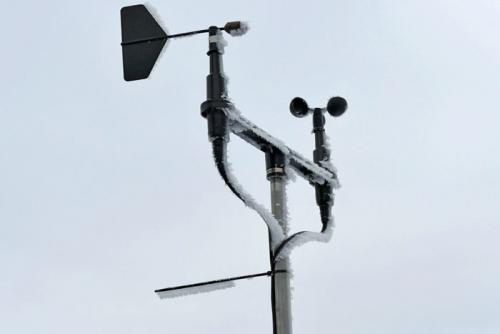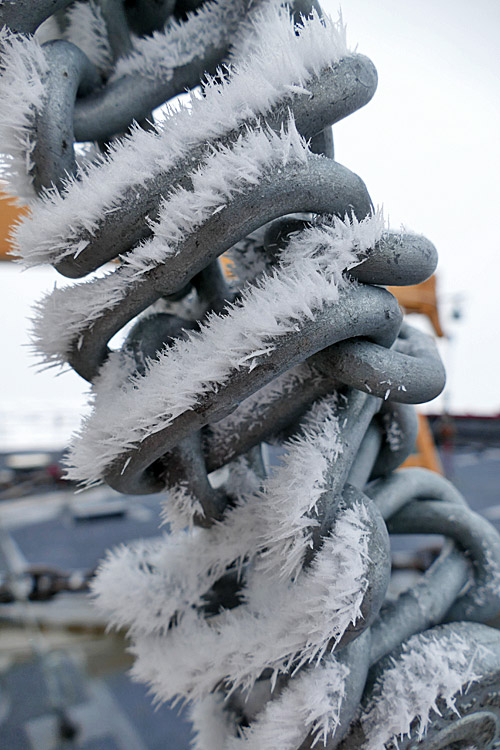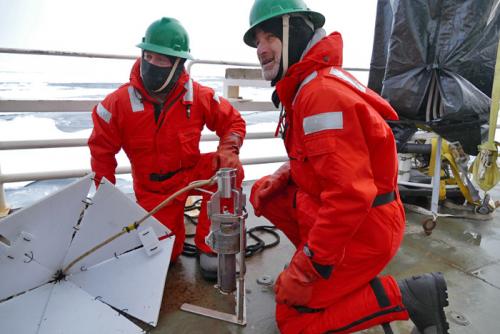Cruise Day 17
Speed 0 knots (kts) (on station)
Course n/a
Location Mendelev Rise, approx. 425nm NE of Jeannette Island, Russia
Depth 2176 m
GO DEEPER DISCUSSION: (see previous journal for the questions.)
Some instruments, like the PAR sensor, need an unobstructed view of the water above them. Others, like the top Chipod, return the best data when they are encountering water before it is influenced by passing through the sampling rosette as it rises. The risk of putting gear above the rosette frame is breaking it off if it bumps anything during deployment or recovery, or if the cable gets around it and peels it off under tension.
TODAY’S JOURNAL:
We are on another repeat hydrography station as I write today, with four more remaining in a string after this one before we reach our next full sampling station. This morning we slipped into the eastern hemisphere, a new significant geographic line for me to cross. While technically we are now a day later courtesy of the International Date Line, we are keeping the same time aboard throughout the cruise to keep things simple. The Executive Officer (XO) was joking with me that if he found out it was someone’s birthday today we’d move the day forward to mess with them.
It was cold and brilliant outside this morning, with occasional banks of fog dampening the brightness. Now we have cloud cover again but excellent visibility. Open leads of water oriented north-south continued to ease our passage last night and early this morning, allowing us to run faster than expected and conserve fuel by running one engine (Healy can put three of its four engines online when needed.) But just before lunch the long leads seem to have ended, at least for the time being, and we are anticipating thicker ice conditions when we transit to the next repeat hydrography station.
 Long north-oriented open water leads such as this one have allowed us to make faster progress towards the pole than expected.
Long north-oriented open water leads such as this one have allowed us to make faster progress towards the pole than expected.
I frequently scan the ice out to the horizon through binoculars in hopes of spotting another bird, polar bear, or seal but so far today I have to be satisfied with several sets of bear tracks that we crossed. Large hoarfrost crystals grew on many exposed surfaces last night, which created a problem for the aerosol samplers. They turn on when the wind is blowing favorably from the bow sector of the ship to avoid getting engine exhaust particle contamination in the filters. This morning, though, the anemometer (a device made of spinning cups to measure wind speed) was frozen in place, so the system thought there was no wind and had turned off the aerosol samplers. Yet another example of a challenge faced by polar scientists.
 The aerosol sampler system anemometer (right) & wind vane (left) got pretty iced up today. For a while the anemometer stopped spinning even though we had gentle breezes. Chris Marsay got it un-iced and working again, and he has been heading aloft every few hours to keep it as ice-clear as possible.
The aerosol sampler system anemometer (right) & wind vane (left) got pretty iced up today. For a while the anemometer stopped spinning even though we had gentle breezes. Chris Marsay got it un-iced and working again, and he has been heading aloft every few hours to keep it as ice-clear as possible.
 Hoarfrost crystals growing on surfaces such as this bundle of chain offer new patterns and textures to contemplate on a walk about the decks.
Hoarfrost crystals growing on surfaces such as this bundle of chain offer new patterns and textures to contemplate on a walk about the decks.
Take a look at the photo below of the ODF 36-bottle rosette coming back up from a cast yesterday. Do you notice anything different?
 ODF 36-bottle sampling rosette with drop line to Mono-Core.
ODF 36-bottle sampling rosette with drop line to Mono-Core.
On the last cast of our full station yesterday, we deployed a bottom sediment-sampling device known as a Mono-Core. It hangs on a line below the rosette, and the idea is to lower the Mono-Core into the sea floor while keeping the rosette out of the mud. To accomplish this, the team used a 24-meter long line, and the scientist controlling the cast, Jim Swift, lowered the rosette to 10 meters above the sea floor as measured by its altimeter. As the Mono-Core reaches the bottom, a stack of lead weights pushes its sampling tube into the soft sediments, with the goal of collecting the top layer as undisturbed as possible along with the water right above it. As the device is raised back up a spring-loaded door closes under the tube to keep the sample in place.
The device had been a little finicky on a couple of prior attempts at recovering bottom sediment. One thought was that the device itself was interfering with the rosette’s altimeter as it hung below the frame, making it difficult to tell when the rosette was getting close enough to the bottom. In response, Marty Fleisher and Tim Kenna rigged what they call a “cone of silence” to deflect the sonar signal outward into the water instead of back up to the altimeter. They also tried lowering the device slowly onto the sea floor to give it the best chance of making contact in a vertical position instead of tipping over sideways. Whatever the case, the cast worked and everyone involved was happy to get a good sediment core and bottom water sample back up on deck from almost 2200 meters deep. Contemplate that for a moment – this little device went down over two kilometers deep (about 1.37 miles) and plucked up a nearly undisturbed bit of the sea floor and bottom water for scientists to study. Not bad!!
 The Mono-Core sampler returning to deck from ~2200 meters deep. Note the so-called “cone of silence” rigged above the sampler to deflect sonar signals from the rosette altimeter.
The Mono-Core sampler returning to deck from ~2200 meters deep. Note the so-called “cone of silence” rigged above the sampler to deflect sonar signals from the rosette altimeter.
 Marty Fleisher and Tim Kenna retrieve a successfully-deployed Mono-Core sampler.
Marty Fleisher and Tim Kenna retrieve a successfully-deployed Mono-Core sampler.
GO DEEPER!
Why did ice accumulate only on certain surfaces on the instruments and chain, and not just cover everything evenly?
Aloft Con web cam updated every hour
Healy Track
That's all for now. Best- Bill


Comments